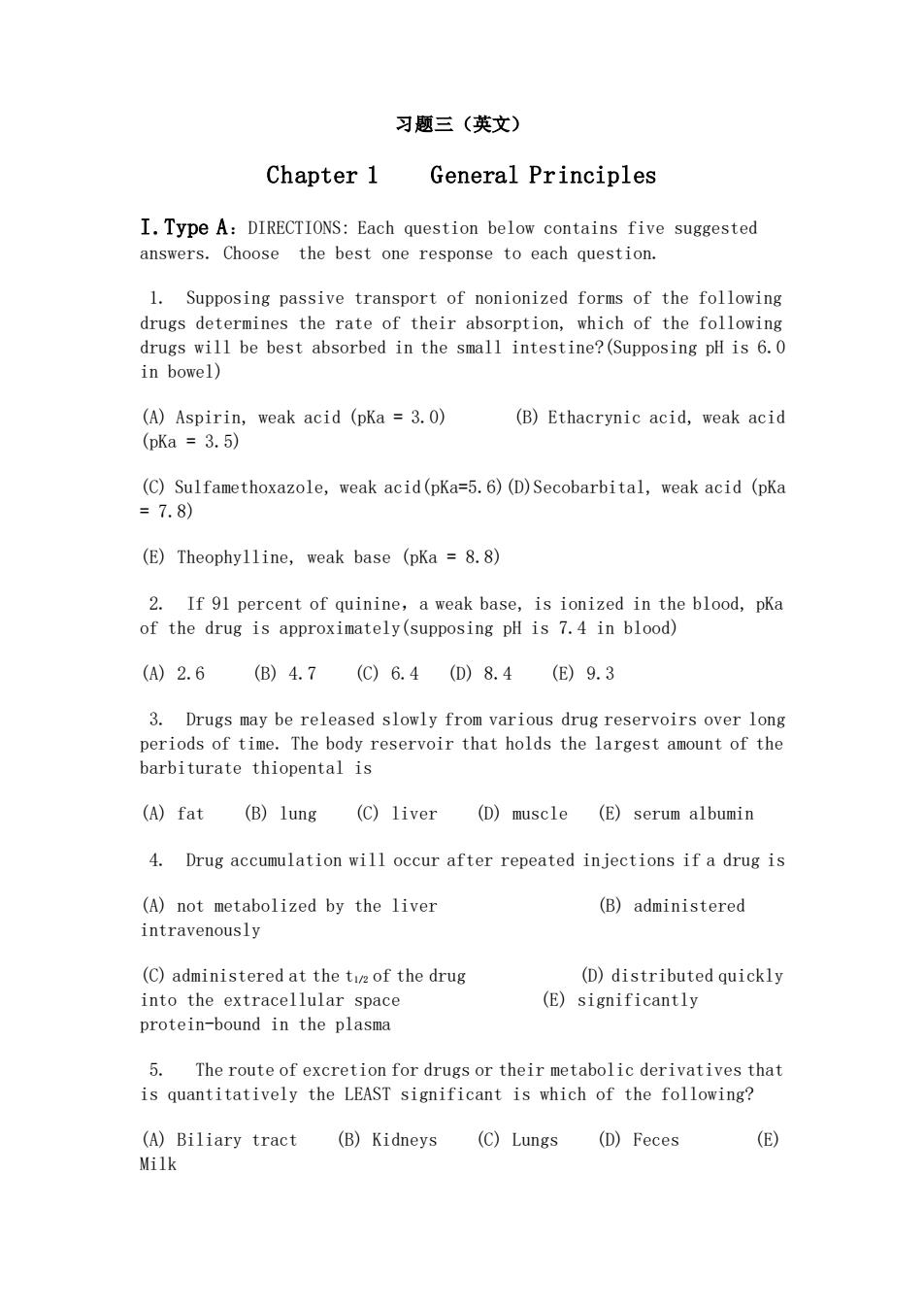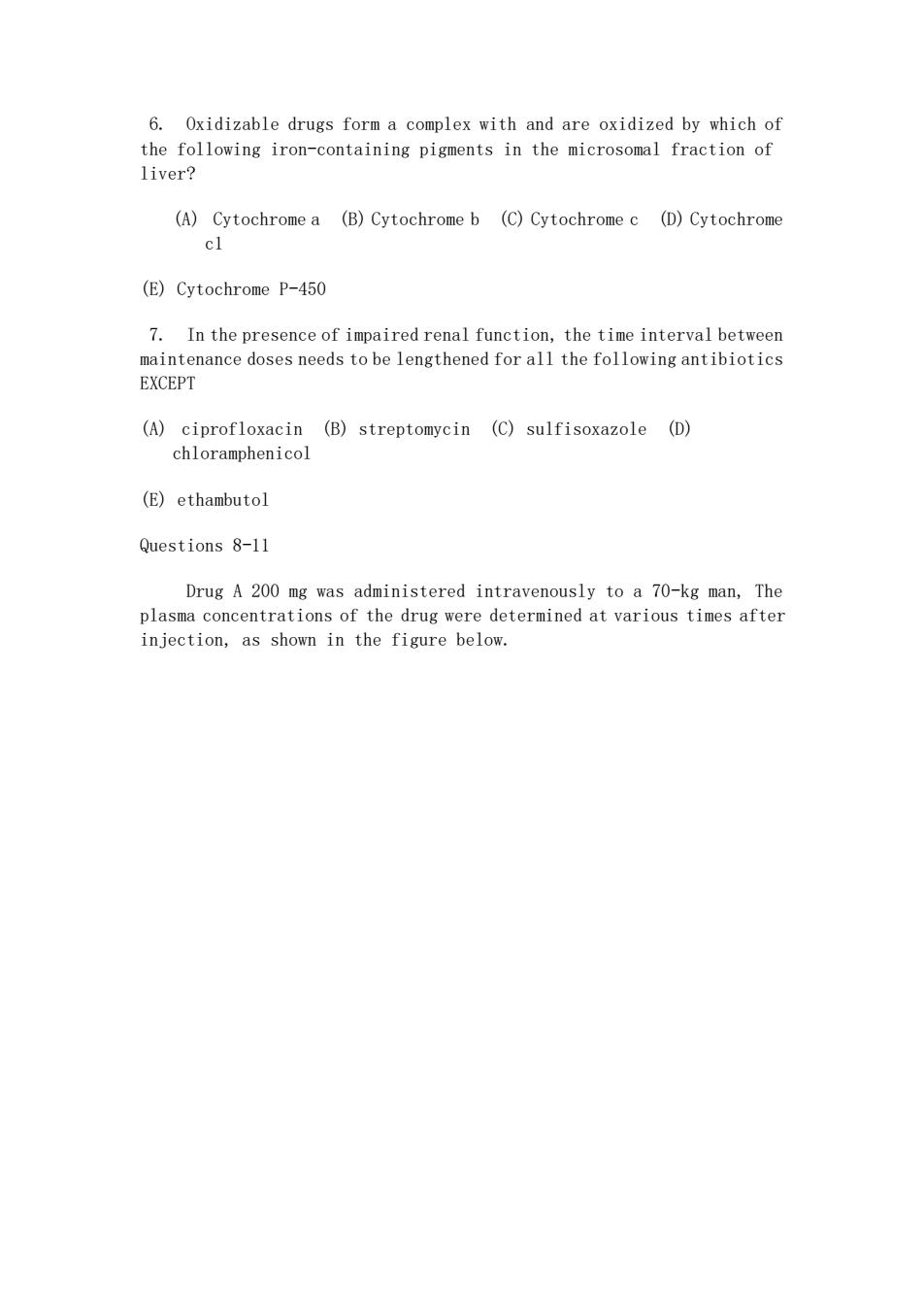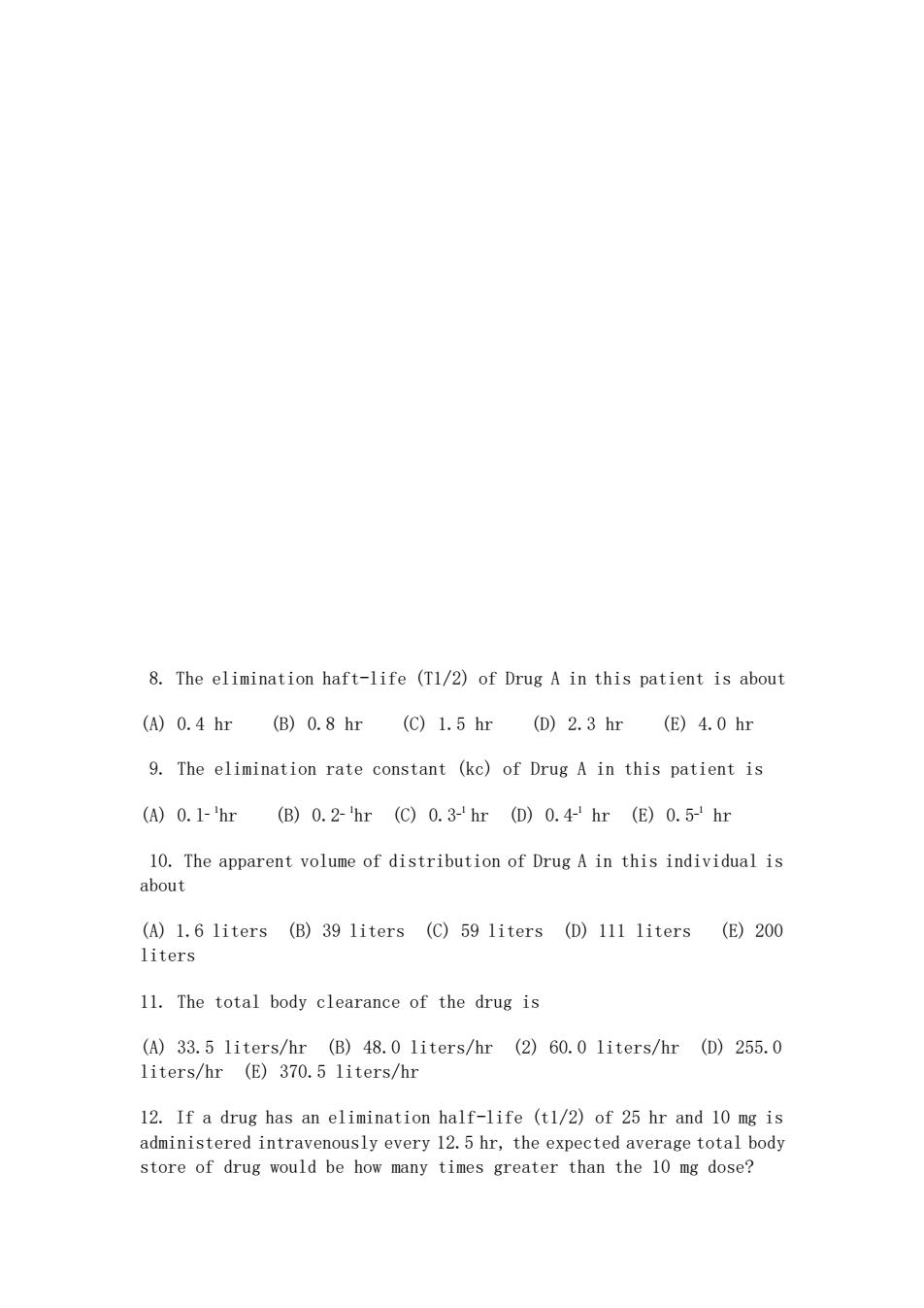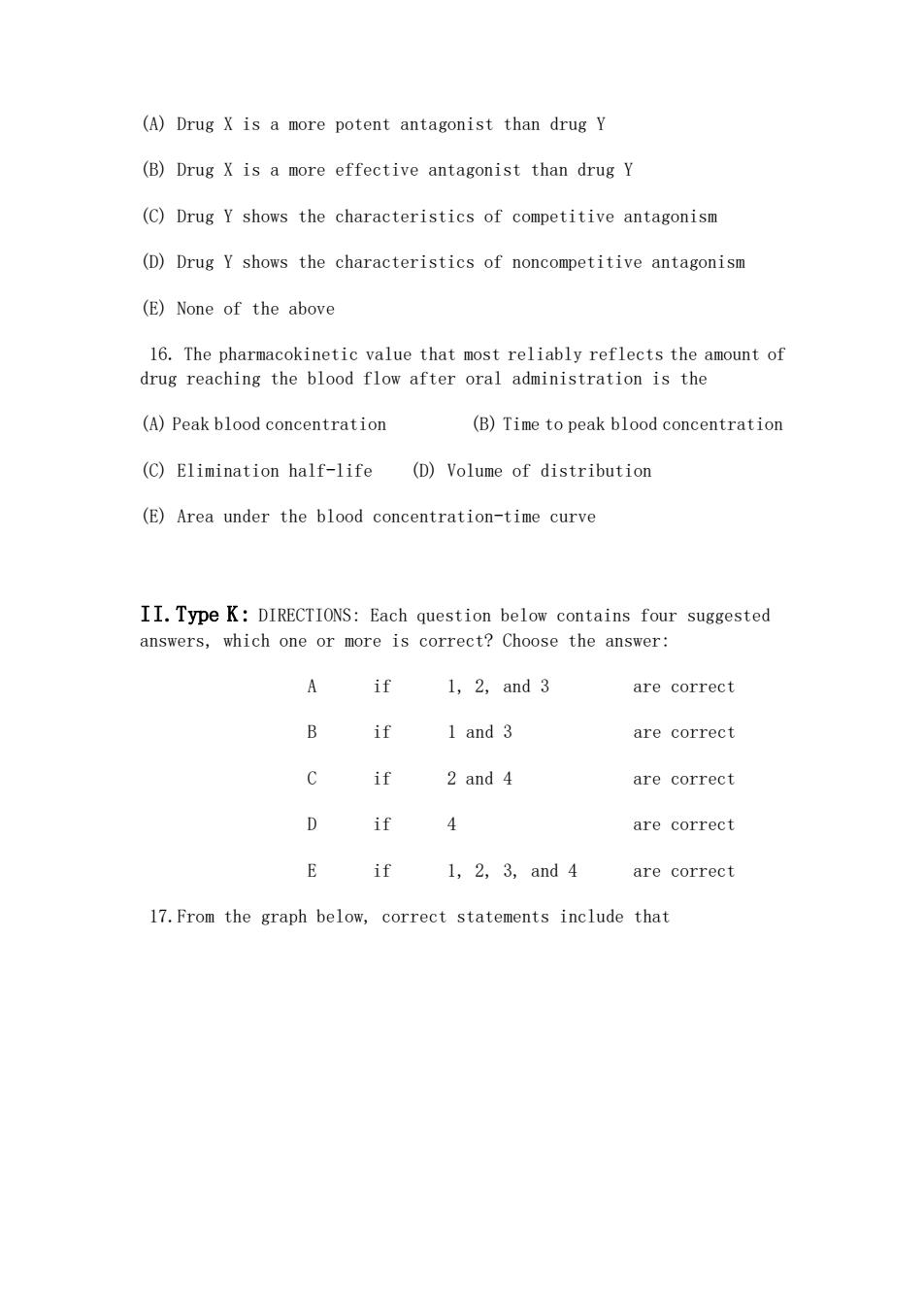
习题三(英文) Chapter 1 General Principles I.Type A:DIRECTIONS:Each question below contains five suggested answers.Choose the best one response to each question. 1.Supposing passive transport of nonionized forms of the following drugs determines the rate of their absorption,which of the following drugs will be best absorbed in the small intestine?(Supposing pH is 6.0 in bowel) gnaiao-a0 (B)Ethacrynic acid,weak acid (C)Sulfamethoxazole,weak acid(pKa=5.6)(D)Secobarbital,weak acid (pKa =7.8) (E)Theophylline,weak base (pKa =8.8) 2.If 91 percent of quinine,a weak base,is ionized in the blood,pKa of the drug is approximately(supposing pH is 7.4 in blood) (A)2.6 (B)4.7 (C)6.4(D)8.4 (E)9.3 3.Drugs may be released slowly from various drug reservoirs over long periods of time.The body reservoir that holds the largest amount of the barbiturate thiopental is (A)fat (B)lung (C)liver (D)muscle (E)serum albumin 4.Drug accumulation will occur after repeated injections if a drug is (A)not metabolized by the liver (B)administered intravenously (C)administered at the t of the drug (D)distributed quickly into the extracellular space (E)significantly protein-bound in the plasma 5.The route of excretion for drugs or their metabolic derivatives that is quantitatively the LEAST significant is which of the following? (A)Biliary tract (B)Kidneys (C)Lungs (D)Feces () Milk
习题三(英文) Chapter 1 General Principles I.Type A:DIRECTIONS: Each question below contains five suggested answers. Choose the best one response to each question. 1. Supposing passive transport of nonionized forms of the following drugs determines the rate of their absorption, which of the following drugs will be best absorbed in the small intestine?(Supposing pH is 6.0 in bowel) (A) Aspirin, weak acid (pKa = 3.0) (B) Ethacrynic acid, weak acid (pKa = 3.5) (C) Sulfamethoxazole, weak acid(pKa=5.6)(D)Secobarbital, weak acid (pKa = 7.8) (E) Theophylline, weak base (pKa = 8.8) 2. If 91 percent of quinine,a weak base, is ionized in the blood, pKa of the drug is approximately(supposing pH is 7.4 in blood) (A) 2.6 (B) 4.7 (C) 6.4 (D) 8.4 (E) 9.3 3. Drugs may be released slowly from various drug reservoirs over long periods of time. The body reservoir that holds the largest amount of the barbiturate thiopental is (A) fat (B) lung (C) liver (D) muscle (E) serum albumin 4. Drug accumulation will occur after repeated injections if a drug is (A) not metabolized by the liver (B) administered intravenously (C) administered at the t1/2 of the drug (D) distributed quickly into the extracellular space (E) significantly protein-bound in the plasma 5. The route of excretion for drugs or their metabolic derivatives that is quantitatively the LEAST significant is which of the following? (A) Biliary tract (B) Kidneys (C) Lungs (D) Feces (E) Milk

6.Oxidizable drugs form a complex with and are oxidized by which of hiniron-containing pignts in the fraction of (A)Cytochrome a (B)Cytochrome b (C)Cytochrome c (D)Cytochrome cl (E)Cytochrome P-450 7.In the presence of impaired renal function,the time interval between maintenance doses needs to be lengthened for all the following antibiotics EXCEPT (A)ciprofloxacin (B)streptomycin (C)sulfisoxazole (D) chloramphenicol (E)ethambutol Questions 8-11 Drug A 200 mg was administered intravenously to a 70-kg man,The plasma concentrations of thedrugwere determined at various times after injection,as shown in the figure below
6. Oxidizable drugs form a complex with and are oxidized by which of the following iron-containing pigments in the microsomal fraction of liver? (A) Cytochrome a (B) Cytochrome b (C) Cytochrome c (D) Cytochrome c1 (E) Cytochrome P-450 7. In the presence of impaired renal function, the time interval between maintenance doses needs to be lengthened for all the following antibiotics EXCEPT (A) ciprofloxacin (B) streptomycin (C) sulfisoxazole (D) chloramphenicol (E) ethambutol Questions 8-11 Drug A 200 mg was administered intravenously to a 70-kg man, The plasma concentrations of the drug were determined at various times after injection, as shown in the figure below

8.The elimination haft-life (T1/2)of Drug A in this patient is about (A)0.4hr(B)0.8hr(C)1.5hr(D)2.3hr(E)4.0hr 9.The elimination rate constant (kc)of Drug A in this patient is (a)0.1hr(B)0.2hr(C)0.3-hr(D)0.4hr(E)0.5hr 10.The apparent volume of distribution of Drug A in this individual is about (A)1.6 liters (B)39 liters (C)59 liters (D)111 liters (E)200 liters 11.The total body clearance of the drug is (A)33.5 liters/hr (B)48.0 liters/hr (2)60.0 liters/hr (D)255.0 liters/hr (E)370.5 liters/hr 12.If a drug has an elimination half-life (t1/2)of 25 hr and 10 mg is administered intravenously every 12.5 hr,the expected average total body store of drug would be how many times greater than the 10 mg dose?
8. The elimination haft-life (T1/2) of Drug A in this patient is about (A) 0.4 hr (B) 0.8 hr (C) 1.5 hr (D) 2.3 hr (E) 4.0 hr 9. The elimination rate constant (kc) of Drug A in this patient is (A) 0.l_ 1hr (B) 0.2_ 1hr (C) 0.3_1 hr (D) 0.4_1 hr (E) 0.5_1 hr 10. The apparent volume of distribution of Drug A in this individual is about (A) 1.6 liters (B) 39 liters (C) 59 liters (D) 111 liters (E) 200 liters 11. The total body clearance of the drug is (A) 33.5 liters/hr (B) 48.0 liters/hr (2) 60.0 liters/hr (D) 255.0 liters/hr (E) 370.5 liters/hr 12. If a drug has an elimination half-life (t1/2) of 25 hr and 10 mg is administered intravenously every 12.5 hr, the expected average total body store of drug would be how many times greater than the 10 mg dose?

(A)1.5(B)3.0(C)4.5(D)6.0(E)12.0 13.It was determined that 95 percent of an oral 80-mg dose of verapamil was absorbed in a 70-kg test subject.However,because of extensive biotransformation during its first pass through the portal circulation, the bioavailability of verapamil was only 25 percent.Assuming a liver blood flow of 1500 ml/min,the hepatic clearance of verapamil in this situation was (A)60 ml/min (B)375 ml/min (C)740 ml/min (D)1110 ml/min (E) 1425 ml/min 14.An enteric-coated dosage form can be used to avoid all the following problems possible from oral drug administration EXCEPT (A)irritation to the gastric mucosa with nausea and vomiting (B)formation of nonabsorbable drug-food complexes (C)unpleasant taste of the drug (D)destruction of the drug by gastric acid or digestive enzymes (E)variability in absorption caused by fluctuations in gastric emptying time 15.The figure below shows the change in mean blood pressure as a result of increasing doses of norepinephrine and the antagonism of this response by drugs X and Y.Using the information provided in the diagram,which statement is correct?
(A) 1.5 (B) 3.0 (C) 4.5 (D) 6.0 (E) 12.0 13. It was determined that 95 percent of an oral 80-mg dose of verapamil was absorbed in a 70-kg test subject. However, because of extensive biotransformation during its first pass through the portal circulation, the bioavailability of verapamil was only 25 percent. Assuming a liver blood flow of 1500 ml/min, the hepatic clearance of verapamil in this situation was (A) 60 ml/min (B) 375 ml/min (C) 740 ml/min (D) lll0 ml/min (E) 1425 ml/min 14. An enteric-coated dosage form can be used to avoid all the following problems possible from oral drug administration EXCEPT (A) irritation to the gastric mucosa with nausea and vomiting (B) formation of nonabsorbable drug-food complexes (C)unpleasant taste of the drug (D) destruction of the drug by gastric acid or digestive enzymes (E)variability in absorption caused by fluctuations in gastric emptying time 15. The figure below shows the change in mean blood pressure as a result of increasing doses of norepinephrine and the antagonism of this response by drugs X and Y. Using the information provided in the diagram, which statement is correct?

(A)Drug X is a more potent antagonist than drug Y (B)Drug X is a more effective antagonist than drug Y (C)Drug Y shows the characteristics of competitive antagonism (D)Drug Y shows the characteristics of noncompetitive antagonism (E)None of the above 16.The pharmacokinetic value that most reliably reflects the amount of drug reaching the blood flow after oral administration is the (A)Peak blood concentration (B)Time to peak blood concentration (C)Elimination half-life (D)Volume of distribution (E)Area under the blood concentration-time curve II.Type K:DIRECTIONS:Each question below contains four suggested answers,which one or more is correct?Choose the answer: A if 1,2,and3 are correct B if I and 3 are correct C if 2 and 4 are correct are correct E if 1,2,3,and 4 are correct 17.From the graph below,correct statements include that
(A) Drug X is a more potent antagonist than drug Y (B) Drug X is a more effective antagonist than drug Y (C) Drug Y shows the characteristics of competitive antagonism (D) Drug Y shows the characteristics of noncompetitive antagonism (E) None of the above 16. The pharmacokinetic value that most reliably reflects the amount of drug reaching the blood flow after oral administration is the (A) Peak blood concentration (B) Time to peak blood concentration (C) Elimination half-life (D) Volume of distribution (E) Area under the blood concentration-time curve II.Type K: DIRECTIONS: Each question below contains four suggested answers, which one or more is correct? Choose the answer: A if 1, 2, and 3 are correct B if 1 and 3 are correct C if 2 and 4 are correct D if 4 are correct E if 1, 2, 3, and 4 are correct 17.From the graph below, correct statements include that